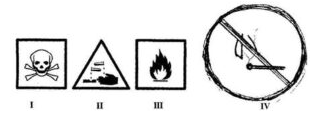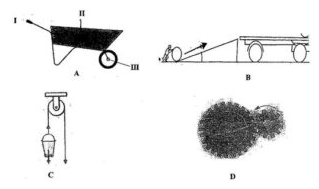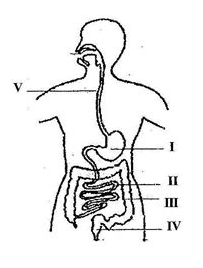1.
An example of a third class lever is
wheelbarrow.
sugar tongs.
pair of scissors.
crowbar.
2.
The release of a mature egg from an ovary into the fallopian tube in humans is called
copulation.
ejaculation.
menstruation.
ovulation.
3.
The blood vessel that carries oxygenated blood from the lungs to the heart is unknown as
pulmonary artery.
pulmonary vein.
vena cana.
aorta.
4.
An example of a plant micro-nutrient is
calcium.
copper.
magnesium.
potassium.
5.
What is the colour of the neutral wire in a three-pin plug?
Blue
Brown
Green
Yellow
6.
In the pin-hole camera, the image formed is always
erect and bright.
erect and blurred.
inverted and real.
inverted and virtual.
7.
The part of the flower that develops into a fruit is the
ovary.
ovule.
stamen.
style.
8.
The number of elements in the compound Ca(OH)2 is
2
3
4
5
9.
The reason why alum is added to water during treatment is to
kill germs.
give taste to water.
make water colourless.
make suspended particles to settle.
10.
Which of the following animal parasites could be controlled by hand picking?
Liver fluke
Tapeworm
Tick
Roundworm
11.
A stick which is partially immersed in water appeared to be bent due to
absorption.
reflection.
refraction.
transmission.
12.
One difference between metals and non-metals is that metals
have low density.
are not malleable.
have lustre.
have low melting points.
13.
The cultivation of different crops on different plots of a farmland in a definite cycle is called
land rotation.
shifting cultivation.
crop rotation.
mixed cropping.
14.
Iodine deficiency in humans could result in a disorder known as
diabetes.
goitre.
kwashiorkor.
scurvy.
15.
A substance is termed combustible if it
easily catches fire.
dissolve common salt.
sublimes at room temperature.
boils at 100oC.
16.
Micro-organisms that cause disease are collectively called
bacteria.
infections.
pathogens.
viruses.
17.
Which type of energy is lost when sweat evaporates from the human body?
Sound energy
Mechanical energy
Chemical energy
Heat energy
18.
Which of the following gases is involved in the rusting of iron?
Hydrogen
Oxygen
Nitrogen
Carbon dioxide
19.
The feeling of soil between fingers is used to determine the
texture of the soil.
drainage of the soil.
capillary of the soil.
water holding capacity of the soil.
20.
Sodium hydroxide is an example of a base because it
has sour taste.
has a pH less than 7.
turns wet blue litmus paper red.
turns wet red litmus paper blue.
21.
Which of the following plants has its leaves modified for storing food?
Ginger
Onion
Pineapple
Tomato
22.
Gases enter and leave the leaf of a plant through the
mesophyll cells.
stomata.
pith.
palisade cells.
23.
Which of the following vegetable crops is cultivated for its leaves?
Carrot.
Lettuce.
Okro.
Pepper.
24.
An example of a body that does not produce its own light is the
moon.
sun.
star.
fire fly.
25.
Which of the following devices converts electrical energy into sound energy?
Electric heater
Electric fan
Washing machine
Loudspeaker
26.
Transplanting of young seedlings is usually done in the evening because
darkness promotes rapid growth.
seedlings require less nutrients.
pest attack is minimal.
transpiration is minimal.
27.
A mixture of sugar and water could be separated by
decantation.
evaporation.
filtration.
sublimation.
28.
Which of the following processes results in the formation of new substances?
Cooling water to form ice
Adding saliva to cooked yam
Dissolving sugar in water
Mixing iron dust and sand
29.
Photosynthesis is important to living organisms because it produces
glucose and oxygen.
glucose and carbon dioxide.
oxygen and carbon dioxide
water and carbon dioxide.
30.
Global warming is caused by the
circulation of oxygen in the atmosphere.
excessive release of carbon dioxide into the atmosphere.
release of hydrogen into the atmosphere.
circulation of nitrogen in the atmosphere.
31.
The warning and safety signs on chemical containers are usually represented by a symbol placed within a
circle.
rectangle.
square.
triangle.
32.
In which of the following structures in a living cell is cellulose found?
Chloroplast.
Mitochondrion.
Cell membrane.
Cell wall.
33.
Elements that could easily lose electrons to form cations are
metals.
non-metals.
semi-metals.
noble gases.
34.
The conversion of agricultural produce from its original form to other desirable forms is termed
preservation.
processing.
recycling.
storage.
35.
The function of the hair in the nose of humans is to
make breathing easier.
keep nose moist.
filter dust from the air breathed in.
keep the nose warm.
36.
A metal that is used as a thermometric liquid is
aluminium.
copper.
mercury.
silver.
37.
The joule is the S.I unit for
energy.
force.
power.
pressure
38.
Which of the following gases supports combustion?
Hydrogen
Oxygen
Carbon dioxide
Carbon monoxide
39.
The form of energy which flows from one point to another due to temperature differences is known as
mechanical energy.
heat energy.
solar energy.
nuclear energy.
40.
Which of the following resources does not produce energy?
Coal
Sand
Water
Wind
a)
The funnels in the diagram below contain equal amounts of different types of soil labelled K, L and M. Equal volumes of water were poured onto each soil at the same time and allow to drain for 20 minutes.
Study the diagram carefully and answer the questions that follow.

i)
What is the aim of the experiment?
ii)
Which soil has the highest rate of drainage?
iii)
Which soil has the highest water retention capacity?
iv)
Which soil is mostly likely to lose water and dry faster after rainfall?
v)
Which soil is mostly likely to be waterlogged after rainfall?
vi)
Which of the soil types would be suitable for maize cultivation?
b)
The diagram below illustrates hazard symbols labelled I, II, III and IV.
Study the diagram carefully and answer the questions that follow.

i)
What does each of the symbols labelled I, II, III and IV represent?
ii)
Name one substance each that is associated with:
α)
I;
β)
II;
γ)
III.
iii)
Name the place where the symbol labelled IV is often displayed.
iv)
Which of the symbol(s) is/are found on chemical containers?
c)
The diagram below illustrations of devices used to do work easily.
Study the diagram carefully and answer the questions that follow.

i)
Give a general name for the devices.
ii)
Identify each of the devices labelled A, B, C and D.
iii)
Name the parts labelled I, II and III of device A when it is considered as a lever.
iv)
What does the arrow represent in the device labelled B?
v)
Name the type of work done with each of the device labelled:
α)
C;
β)
D.
d)
The diagram below illustrates the digestive system in humans.
Study the diagram carefully and answer the questions that follow.

i)
Name each of the parts labelled I, II, III, IV and V.
ii)
Name the part(s) of the digestive system where:
α)
digestion of food substances occur;
β)
digested food is absorbed into the bloodstream.
iii)
Name the end-products of the digestion that is absorbed into the bloodstream.
a)
Name four weather measuring instruments.
b)
Name the stages in the life cycle of a mosquito.
c)
i)
List two properties of water.
ii)
Explain why it is advisable to wash clothes with soft water.
d)
State three ways in which soil profile is important.
a)
List three modes of heat transfer.
b)
i)
What is a deficiency disease?
ii)
Name three deficiency in humans.
c)
State two ways in which each of the following factors causes depletion of soil resources:
i)
Burning;
ii)
Leaching.
d)
List three processes that can change matter from one state to another.
a)
i)
What is a satellite?
ii)
Give three uses of artificial satellites.
b)
State the composition of each of the following alloys:
i)
Brass
ii)
Steel
iii)
Bronze
c)
Name three cultural practices used in vegetable production.
d)
List four parts of the respiratory system in humans.
a)
i)
What is a force?
ii)
State two ways in which force could affect a body.
b)
i)
What is a chemical change?
ii)
State three difference between chemical change and physical change.
c)
Name three physical properties of soil.
d)
Mention three diseases of the circulatory system in humans.
a)
Write the systematic name for each of the following compounds.
i)
H2O;
ii)
MgO;
iii)
CaO;
iv)
CaCl2.
b)
Name the instrument used in measuring the following:
i)
Length of a rope;
ii)
Mass of a stone;
iii)
Temperature of a liquid;
iv)
Volume of a liquid.
c)
List three factors that influence vegetable crop production.
d)
Name four stages in the cycle of a flowering plant.